 |
| Picture by Kolohe |
Las Cruces (population 111,385), New Mexico, is the second-most populous city in the state. Interstate 10 runs east-west and Interstate 25 runs north-south as they cross through the City.
On the south side of Interstate 10 is a Roadrunner sculpture constructed from all types of scrap materials. While most large-junk-item sculptures are made from metal and welded together, this Roadrunner has a mesh framework and the scrap items are wired to the mesh. Scrap items include everything from an old paint brush to a computer keyboard. Definitely unique!
 |
| Picture by Kolohe |
 |
| Picture by Kolohe |
 |
| Picture by Kolohe |
Trail of the Whispering Giants is a collection of Indian sculptures across the United States and Canada made by Peter Wolf Toth. There is at least one of his statues in every state. "Dineh" is located in Las Cruces and is statue #54 out of 74.
 |
| Picture by Kolohe |
 |
| Picture by Kolohe |
 |
| Picture by Kolohe |
Although Hatch is reported to be the "Chile Pepper Capital of the World," the "World's Largest Chile Pepper" is located in Las Cruces. The large Chile Pepper is located in front of a hotel and everything in the hotel is Chile-themed. There is even a "Chile Garden" in the hotel courtyard.
It is difficult to miss the Space Murals Museum in Organ (population 242) because the murals are painted on the outside of a large 1.2 million gallon abandoned water tank adjacent to US Highway 70.
Surrounding the tank are various outdoor displays, including part of an actual German V-2 rocket that was test fired and recovered at nearby White Sands Missile Range.
 |
| Picture by Kolohe |
 |
| Picture by Kolohe |
 |
| Picture by Kolohe |
The tank's interior has been developed with a space museum containing artifacts collected by a former White Sands Missile Range employee, and other items on loan from private collections and the Federal Government. Included in the museum are a Mercury capsule mock-up, space station model, actual Titanium fuel cell, photographs, newspapers, and a gift shop.
 |
| Picture by Kolohe |
Located at the San Augustin Pass rest area is a Nike missile display overlooking the White Sands Missile Range.
 |
| Picture by Kolohe |
The White Sands Missile Range Museum is the only thing open to the public at the missile range, and getting to the museum is no quick and easy process. You have to have a valid driver's license, vehicle registration, proof of insurance, vehicle inspection, have your picture taken, and then go through a security check in order to be issued a one-day visitor pass for the museum complex only.
The museum consists of two separate buildings and an outdoor Rocket Garden. One building is dedicated entirely to the German V-2 Rocket. An actual V-2 Rocket is on display and several exterior panels have been removed so the interior parts of the rocket are exposed.
 |
| Picture by Kolohe |
 |
| Picture by Kolohe |
 |
| Picture by Kolohe |
The Rocket Garden contains numerous different types of rockets that were tested at the White Sands Missile Range. There is also an atomic bomb casing on display.
We were warned that pictures could only be taken while looking certain directions, so taking some rocket pictures was difficult.
 |
| Picture by Kolohe |
 |
| Picture by Kolohe |
 |
| Picture by Kolohe |
 |
| Picture by Kolohe |
 |
| Picture by Kolohe |
White Sands National Park is located adjacent to the White Sands Missile Range.
The Park contains 145,762 acres and is known for the white sand dunes that are composed of gypsum crystals. This is the largest gypsum dune field in the world. In 1933 White Sands was designated a National Monument and changed to a National Park in 2019. The visitor center and other adobe buildings were constructed in 1936 as a Work Progress Administration (WPA) project
Dunes in the Park are as tall as 60 feet and the gypsum field is estimated to contain 4.5 billion tons of gypsum sand. The dunes are still growing because strong winds blowing from the northwest continue to carry gypsum crystal to the Park.
Downhill sledding, skiing, and surfing are allowed on the dunes and White Sands is one of the few National Parks where you are allowed to carve your name or leave message in the sand.
 |
| Picture by Kolohe |
 |
| Picture by Kolohe |
 |
| Picture by Kolohe |
 |
| Picture by Kolohe |
 |
| Picture by Kolohe |
 |
| Picture by Kolohe |
 |
| Picture by Kolohe |
 |
| Picture by Kolohe |
 |
| Picture by Kolohe |
 |
| Picture by Kolohe |
 |
| Picture by Kolohe |
 |
| Picture by Kolohe |
The New Mexico Museum of Space History in Alamogordo was closed when we arrived, so it is an item that I did not cross off of my bucket list. However, we were able to walk around the grounds to view the exterior exhibits as the sun was sitting in the west. The Museum includes the International Space Hall of Fame.
 |
| Picture by Kolohe |
 |
| Picture by Kolohe |
 |
| Picture by Kolohe |
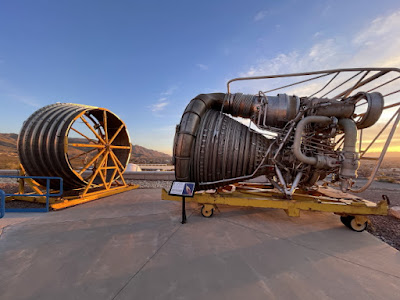 |
| Picture by Kolohe |
 |
| Picture by Kolohe |
Ham, the chimpanzee who in 1961 became the first ape in space, died in 1983 and is buried in front of the International Space Hall of Fame sign.
The Astronaut Memorial Garden was created and dedicated to the astronauts who died in the Space Shuttle Challenger and Columbia disasters.
Adjacent to the Astronaut Memorial is the John P. Stapp Air and Space Park exhibit area that contains the famous Sonic Wind No. 1 Rocket Sled ridden by Stapp at Holloman AFB.
 |
| Picture by Kolohe |
 |
| Picture by Kolohe |
It was getting dark, but we still found time to see the "World's Largest Pistachio" and other interesting items in the same area. The Pistachio is 30-feet tall.
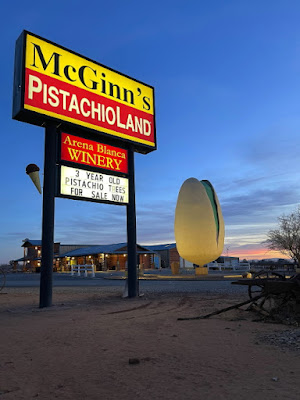 |
| Picture by Kolohe |
A short distance away was the "World's Largest Glowing Heart." It is 26-feet tall, 20-feet wide, and designed to withstand winds up to 114-miles-per-hour. It was reported to be a popular spot for marriage proposals.
Just down the street was a 15-foot tall scrap-metal Roadrunner in front of a recycling company.
Located on a side street there was a skeleton on a chopper doing a wheelie and a VW Spider with glowing red eyes.
 |
| Picture by Kolohe |
 |
| Picture by Kolohe |
 |
| Picture by Kolohe |
 |
| Picture by Kolohe |




























































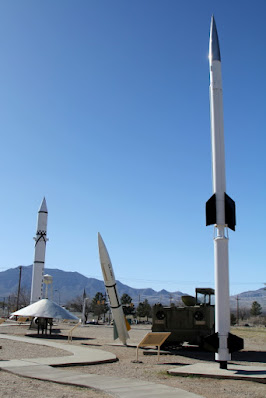


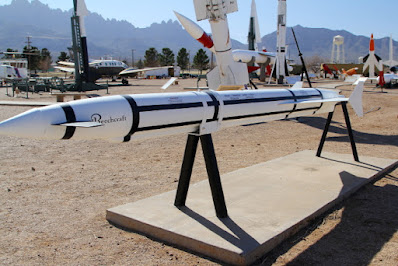












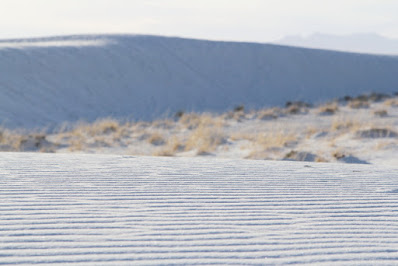







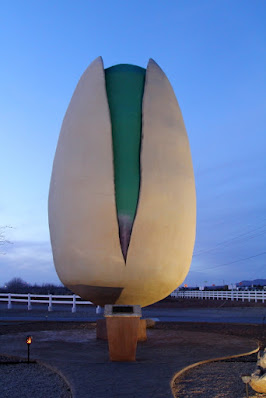

No comments:
Post a Comment